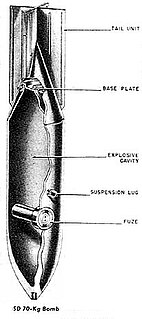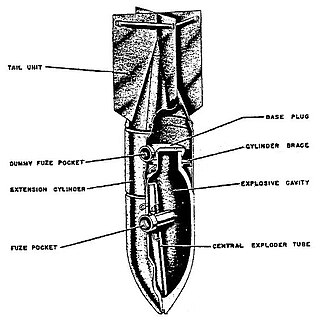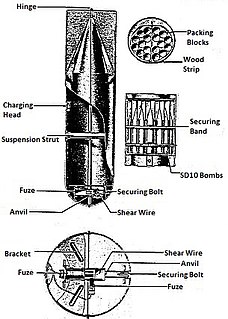
A Butterfly Bomb was a German 2 kilogram anti-personnel submunition used by the Luftwaffe during the Second World War. It was so named because the thin cylindrical metal outer shell which hinged open when the bomblet deployed gave it the superficial appearance of a large butterfly. The design was very distinctive and easy to recognise. SD 2 bomblets were not dropped individually, but were packed into containers holding between 6 and 108 submunitions e.g. the AB 23 SD 2 and AB 250-3 submunition dispensers. The SD 2 submunitions were released after the container was released from the aircraft and had burst open. Because SD 2s were always dropped in groups the discovery of one unexploded SD 2 was a reliable indication that others had been dropped nearby. This bomb type was one of the first cluster bombs ever used in combat and it proved to be a highly effective weapon. The bomb containers that carried the SD 2 bomblets and released them in the air were nicknamed the "Devil's Eggs" by Luftwaffe air and ground crew.

A general-purpose bomb is an air-dropped bomb intended as a compromise between blast damage, penetration, and fragmentation in explosive effect. They are designed to be effective against enemy troops, vehicles, and buildings.

The CBU-100 Cluster Bomb is an American cluster bomb which is employed primarily in an anti-tank mode. It weighs 222 kg and carries 247 Mk 118 Mod 1 bomblets.

The SC 250 was an air-dropped general purpose high-explosive bomb built by Germany during World War II and used extensively during that period. It could be carried by almost all German bomber aircraft, and was used to notable effect by the Junkers Ju 87 Stuka. The bomb's weight was about 250 kg, from which its designation was derived.

The SC 1000 was a large air-dropped general-purpose thin cased high explosive demolition bomb used by Germany during World War II. Weighing more than 1,000 kg (2,200 lb), it was nicknamed the Hermann by the Germans in reference to the portly Luftwaffe commander, Hermann Göring.

The Stielgranate 42 was a German fin-stabilized demolition charge, used with the 15 cm SIG 33 heavy infantry gun and armored vehicles armed with the SIG 33 during World War II. The primary purpose of the Stielgranate 42 was the demolition of concrete fortifications and for the clearing of minefields and barbed wire. Unlike the Stielgranate 41 it was not a shaped charge anti-tank weapon. In an emergency, the Stielgranate 42 could be used in an anti-tank role to great effect but due to its short range and poor accuracy the gun crew would be dangerously exposed to enemy fire.

The AB 70-D1(Abwurfbehälter) was a cluster bomb dispenser used by the Luftwaffe during World War II.

The SC 2500 or cylindrical explosive bomb in English was a general purpose bomb used by the Luftwaffe during World War II.

The AB 250-2(Abwurfbehälter) was a cluster bomb used by the Luftwaffe during World War II.

The BDC 10 was a cluster bomb used by the Luftwaffe during World War II.

The AB 23(Abwurfbehälter) was a cluster bomb used by the Luftwaffe during World War II.

The SB 2500 (Spezialbombe) was a luftmine or aerial mine in English used by the Luftwaffe during World War II.

The SD 50 or thick walled explosive bomb in English was a fragmentation bomb used by the Luftwaffe during World War II.

The SD 70 or thick walled explosive bomb in English was a fragmentation bomb used by the Luftwaffe during World War II.

The SD 250 or thick walled explosive bomb in English was a fragmentation bomb used by the Luftwaffe during World War II.

The SD 1700 or thick walled explosive bomb in English was a fragmentation bomb used by the Luftwaffe during World War II.

The SD 15 or thick walled explosive bomb in English was a fragmentation bomb used by the Luftwaffe during World War II.

The AB 500-3A(Abwurfbehälter) was a cluster bomb used by the Luftwaffe during World War II.

The AB 500-1B(Abwurfbehälter) was a cluster bomb used by the Luftwaffe during World War II.

The AB 500-1(Abwurfbehälter) was a cluster bomb used by the Luftwaffe during World War II.























